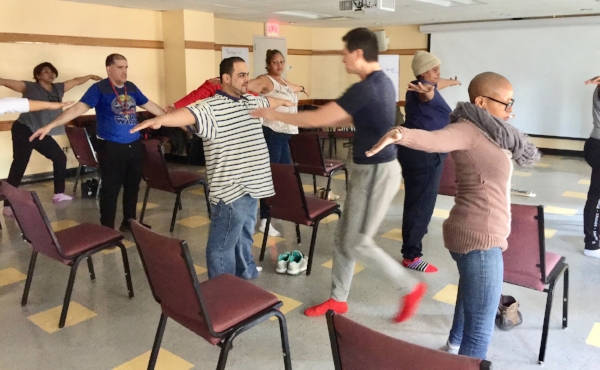Yoga and the Art of Remembering
/Art work on the Palestinian side of a border wall that separates Palestinian and Israeli controlled territories in Bethlehem.
From the Dhammapda, a collection of the Buddha's important teachings, Chapter 1, verse 6 reads (Gil Fronsdal translation):
Many do not realize that
We here must die.
For those who realize this,
Quarrels end.
While visiting Israel over the summer, my partner, Ed, and I stopped at the border wall above. What a truly difficult and tenuous situation it is in this part of our One world, where awareness of death is so palpable on a daily basis. As this recent NY Times article about the meaning of Yom Kippur suggests, the recently passed observance of Yom Kippur is a “dress rehearsal for our deaths.” It quotes a 19th-century rabbi, Rabbi Simcha Zissel Ziv, who said, “remembering death in the proper way can bring a person to the ultimate joy” and a contemporary rabbi, Angela Buchdahl, who says, it “compels us to squeeze out every bit of life out of every day that we have.” Indeed, one thing that Ed and can say we observed in Israel is that people there do squeeze out a lot of joy in their daily lives . In some ways, they practice one of the Buddha’s core teachings: “Practice living joyfully amidst all the sorrows of the world.”
I would say that as practitioners of yoga, we are compelled as well to realize, on a daily basis at least, that one day we won’t be here on this earth. As our yoga practice grows over the year, it moves from glorification of the physical to a deeper awareness of the spiritual. It can lead to a greater and deeper experience of Joy.
The verse just prior to the one above from the Dhammapada reads:
Hatred is never ended by hatred - but by love.
This is an eternal rule.
Of course it is quite easy to mouth these words, but in fact so difficult to actually meet hatred with love. But as yoga practitioners it is our duty to try to get better and better at practicing this — if not outwardly then at least internally — so that we never have to experience the horrific events of 9/11 again. Hard to believe they happened just seventeen years ago. Hopefully by this time some of the hatred has been replaced by love. It is possible to meet our own feelings of self-hatred — yes everyone has those feelings from time to time — with love and compassion. For example, when we’re practicing savasana or seated meditation and putting our attention on the gentle rise and fall of our bellies over and over again, we’re actually physicalizing this concept of meeting hatred with love.
So much of practicing yoga is actually about unearthing, removing, and remembering. One of my favorite poems is this comforting one by Derek Walcott (Nobel Laureate in Literature from St. Lucia) called Love After Love:
The time will come
when, with elation
you will greet yourself arriving
at your own door, in your own mirror
and each will smile at the other's welcome,
and say, sit here. Eat.
You will love again the stranger who was your self.
Give wine. Give bread. Give back your heart
to itself, to the stranger who has loved you
all your life, whom you ignored
for another, who knows you by heart.
Take down the love letters from the bookshelf,
the photographs, the desperate notes,
peel your own image from the mirror.
Sit. Feast on your life.
As I near the start of my 7th decade here on this earth — in just 7 months from now! — I look back now at my youthful days and remember the desperate notes to former would-be lovers and casting directors (during my former acting days) wishing for their love and affirmation of my worth. I can understand why Sally Field said what she said in her Oscar acceptance speech in 1984! I can definitely say that yoga and meditation have helped bring me closer to seeing more fully my little self and the bigger Self. I have more of an understanding and awareness of my Dharma — my duty to serve — and where I fit into the bigger picture of Life. And as I contemplate now returning to acting professionally, I have a deeper desire to be seen for who I am. As I said to a headshot photographer I interviewed recently, I want to be shot as I am today, and not as some glorified image of myself. Yoga as well as life’s natural progression have gently brought me to this point, thankfully.
At this moment in our US politics, we are being rocked with sexual abuse allegations against a Supreme Court nominee. So many minds at the moment are conflicted, and what is needed most right now are quiet minds that can see through the false colorings of the truth and come to quiet decisions on the best course of action going forward. As this passage from A Course in Miracles says:
The memory of God comes to the quiet mind. It cannot come where there is conflict. A mind at war with itself remembers not Eternal Gentleness.
So many minds are at war with themselves at the moment, perhaps including your own. As you practice yoga and meditation more and more — as your inner conflicts are assuaged a bit more each moment you put your attention on your breath — please know that you are helping the bigger picture by coming closer to remembering more often — and at a deeper level — who you really are. Remembering God means remembering how inextricable and interconnected we all are.
May you be better able to meet hatred with love, …
May you feast on your life, …
May you remember who you really are, …
… for the benefit of all beings.
Aloha with Metta,
Paul Keoni



















